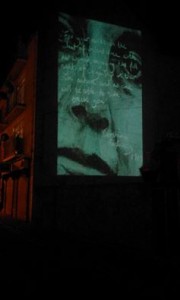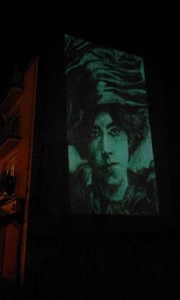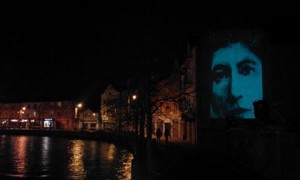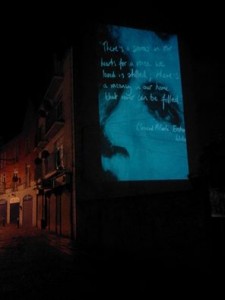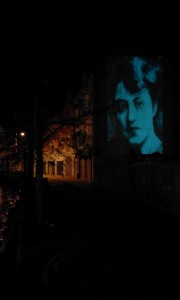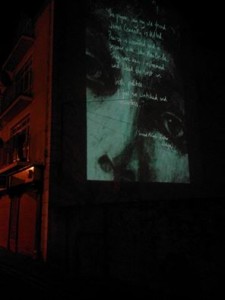Here is an unedited copy of the speech I gave on launch night of Spotlights and Shadows March 2016. I think it will give you a good idea of the project.
“Welcome to our launch of Spotlights and Shadows.
This is a collaborative project between The Hyde Bridge Gallery, Projection Designer Joe Hunt and myself.
As the light fades each night over the next 10 days a portrait of a woman and a quote regarding her experience of The Rebellion will appear on the wall here behind the gallery.
The work is designed to commemorate the events of 1916 by reigniting the presence of these 10 women, all of them involved in the struggle for freedom for all on the island of Ireland 100 years ago. It should be noted that the 10 women that will appear here over the next 10 days are by no means a finite list. 77 women were imprisoned in Kilmainham Gaol as a result of their participation in The Rising and so many more lives were profoundly changed by events that took place. In addition to that many women began vital work for the cause in reaction to The Rebellion and it would be impossible to honour each and every one of them as individuals. I would like to think that the women featuring in the project are representative of all the women and also of the personal stories as well as the political ones. They were of course carefully chosen:
- Constance for her key role in The Rebellion and in the turbulent years that followed.
- Elizabeth O’Farrell for her courage and bravery in delivering the surrender.
- Margaret Skinneder for her determination regarding her own liberation as a woman as well as the political freedom of Ireland.
- Maud Gonne- MacBride, Grace Plunkett-Gifford, Muriel MacDonagh, Lillie Connolly, Agnes Mallin, Aine Ceannt and Kathleen Clarke were all married to men who were executed for their involvement in The Rising. Those men are commemorated here by their absence, from May 1916 their wives and families had to find a way to carry on without them. In some cases their widows carried on the work they had begun and none of them gave up the ideal of Ireland free and the personal and political freedom fought for by their loved ones. As individuals these women all lead remarkable lives and their stories highlight the very personal experiences lesser heard in the history books and in the classroom.
I hope that the presence of these women in Sligo over the coming nights will not only remind you of the history and the familiar stories but also arouse a curiosity in you to find out more about the hidden stories that are floating to the surface and coming to light this year. Making work on this subject has proved to be an amazing adventure. I have met some truly fascinating people, including relatives and every time the work is shown new stories come bouncing back to me that I haven’t heard before in emails from people eager to share their own personal connections with the women in the portraits. I’m hoping that this piece will also develop a life of it’s own and act as a catalyst in the same way, that it may begin some new conversations even if I don’t get to hear them!
It seemed only fitting that tonight we should begin with Constance due to her strong Sligo links and active role in 1916, but it is just the beginning so I would like to give you a flavour of what lies ahead by telling you a little about each woman and reading the quote that features in her projection.
The quotes are from Sinead McCoole’s book Easter Widows, Margaret Skinneder’s ‘Doing My Bit for Ireland’, Mary Pat Kelly’s ‘Women of The Rising’ and the Constance quote is taken from a speech she gave to The Irish Women’s Franchise League in 1915.
(1) Constance Markievicz (Constance was the only woman to be sentenced to death for her actions during The Rising. This was changed to life imprisonment due to her being a woman. Released a year later she went on to lead an active political life becoming the first woman to hold a cabinet position in Ireland’s government).
“Fix your minds on the ideal of Ireland free with her women enjoying the full rights of citizenship in their own nation and no one will be able to sidetrack you.”
(2) Kathleen Clarke (widow of Tom Clarke, but also was an activist prior to The Rising and a founding member of Cumann na mBan and lead a strong political life in the years that followed)
“I was feeling that the world was tumbling around me, though I did not say so… As far as I was concerned my happiness was at an end.”
(3) Maud Gonne-MacBride (Maud had been an activist for many years and if it weren’t for her I don’t think women would have had the opportunity to play such a strong role in The Rebellion. She was separated from her husband John MacBride at the time of his execution and was living in France. She read the news in the papers.
“The papers say my old friend James Connolly is killed. Pearse is wounded and a prisoner with John MacBride. They were men I esteemed and liked the best in Irish politics…. I feel so wretched and powerless.”
(4) Lillie Connolly, (Wife of James Connolly wrote this in her bible following her husbands execution)
“There’s a sorrow in our hearts for a voice we loved is stilled; there’s a vacancy in our home that never can be filled.”
(5) Áine Ceannt (Wife of Eamonn Ceannt and active member of Cummann na mBann worked tirelessly for the children’s relief fund and was a founding member of the Irish Red Cross. The day The Rising began she had to leave her home wearing as many clothes as she possibly could and carrying all her money and possessions in a picnic basket just in case she was being watched.)
“I crossed the threshold of that house, which would never mean home to me again, and closing the door I said farewell for ever to my ten years of happy married life.”
(6) Grace Plunkett-Gifford (Grace famously married Joseph Plunkett in Kilmainham Gaol just hours before he was executed. She was an artist and llustrator and used her talents in the creation of propaganda for the cause)
“We who had never enough time to say what we wanted to each other found that in the last ten minutes we couldn’t talk at all.”
(7) Muriel MacDonagh (Wife of Thomas Macdonagh and sister to Grace was kept out of the loop prior to The Rebellion and actually didn’t find out about his execution until after the event. She represented him and his ideals any way she could after The Rising often being seen out wearing his Cap and Gown.Tragically she died just a year later in a drowning incident. She was trying to swim out to an island just of Skerries to plant the Irish Flag in honour of her husband at the time.
‘He said, “I may or may not be back to see you tomorrow, if possible I will come in the morning.” He did not say anything about the Revolution. I never saw him afterwards.’
(8) There is no recorded quote from Agnes Mallin (wife of Michael Mallin) but this is an observation from James O’Shea on meeting Agnes on Easter Tuesday 1916, Agnes was pregnant with their last child at the time. Unlike Muriel, she was well informed of her husband’s plans.
“She appeared as if the weight of the world was on her shoulders… and so it was… she was pale and very shaken but I admired her courage… she knew all.”
(9) Margaret Skinneder, (Margaret was Scottish and a member of Cumann na mBan. She was a trained markswoman and is said to have smuggled ammunition into the country under her hat. She was active on Stephen’s Green with Constance and Michael Mallin)
“They laid me on a table and cut away the coat of my fine new uniform. I cried over that. Then they found I had been shot in three places.”
(10) Elizabeth O’Farrell (Elizabeth was selected by Pearse to deliver the surrender, a task that required immense courage and bravery, to walk through the streets of Dublin and get the message to each site of combat as fighting continued, her only protection – a white flag.)
“I waved the small white flag which I carried and the military ceased firing and called me up to the barrier.”
I would like to thank Sligo CO.CO. For funding this project and making us a part of their 2016 Commemorative programme and The Model for their generous loan of equipment.
I thank Sinead McCoole (author of Easter Widows the book that inspired 7 of the drawings) and Grainne Blair for their guidance and encouragement and my good friends Liz Longworth and Aideen Connolly for their input and their precious time.
I’d like to end by saying how thankful I am to have had the opportunity to work in collaboration with The Hyde Bridge Gallery and with Joe. Nothing was ever a problem for Sarah, Paul and John, they really have been fantastic. I’m quite in awe of Joe’s technical talents and his pure confidence in the success of the project has made me feel confident. I’m truly grateful for that. He can’t be here tonight as he is working his magic at The Factory on Blue Raincoat Theatre Company’s production of Shackleton…..another must see.
I hope you Enjoy the rest of the night and as you pass the Garavogue river this Easter time don’t forget to glance up at the wall and cast a thought for those people from 100 years ago, their stories, their ideals and their legacy.”
Emma Stroude
March 2016
- Elizabeth O’Farrell
- Constance Markievicz
- Grace Plunkett Gifford
- Muriel MacDonagh
- Kathleen Clarke
- Margaret Skinneder
- Aine Ceannt
- Lillie Connolly
- Agnes Mallin
- Maud Gonne MacBride



